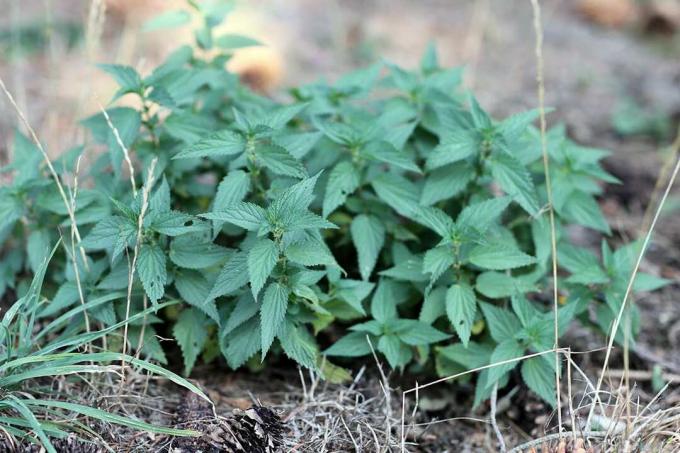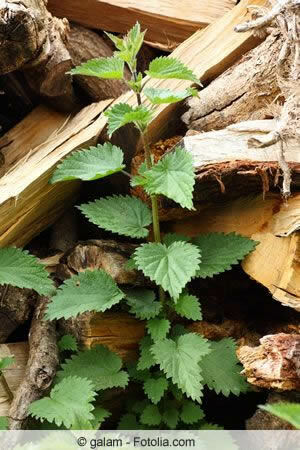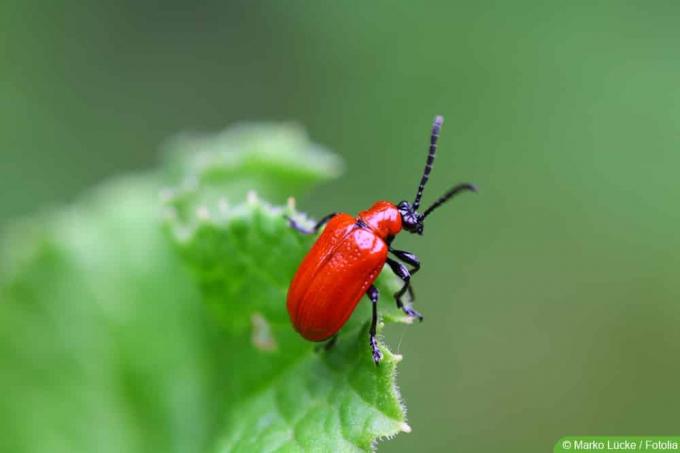

Table of contents
- Which nettles are suitable?
- Use of nettle decoction
- ingredients
- Materials needed
- Pick nettles
- start the brew
- cold water extract
- hot water extract
- Application
- nettle manure
- Which approach for which application?
- Conclusion
With the broth of nettles, aphids can be fought in an environmentally friendly and biological way. However, the remedy is not a silver bullet, so the plants should be checked frequently for infestation. Nettle decoction is not only very effective in the early stages of aphid infestation. It can also be used against annoying weeds that grow between the paving stones, rolled surfaces or on the steps of stairs and are difficult to remove.
Which nettles are suitable?
nettles (utica) belong to the nettle family and are found almost everywhere in the world. We mainly have the Great Nettle (Urtica dioica) and the little nettle (Urtica urens) widespread. The upper plant parts of both species are suitable for preparing nettle stock, with the smaller species being considered the more aggressive. Harvesting is best done on a sunny day in early May, just before flowering. dead nettles
(lamium) belong to a different plant genus and are therefore unsuitable.Use of nettle decoction
The smell and some active ingredients from the stinging nettle have a repellent effect on lice and spider mites. The brew also contains nutrients that strengthen the plants. Nettle decoction can also be sprayed on leaves and flower buds to counteract deficiency symptoms.
- Spray the leaves and shoots against aphids, spider mites and whiteflies
- Root bath when wilting potted plants
- also works against leaf chlorosis when sprayed on (as a fertilizer)
- acts as a bioherbicide against weeds
ingredients
The stinging nettle not only contains formic acid as a repellent, which the pests do not tolerate well, but also a whole lot of other plant active ingredients and nutrients. These are released into the brew and are therefore readily available for the plants. These include:
- iron
- other minerals
- Flavonoids (antioxidants)
- Carotenoids (antioxidants)
- Vitamins A, C and E
- phosphorus
- potassium and calcium
- Nitrogen
- Silicic acid (strengthens the cell walls and the immune system)
- Amines (in the stinging hairs) promote the green formation of the leaves
Materials needed

If you want to use nettle brew for pest control or weed killing, you need a few things that are usually available in every household with a garden:
- nettles
- water (preferably rainwater)
- Bucket and grid for covering
- Rose Scissors
- possibly blender
- garden gloves
- Sieve
Pick nettles
Which gardener does not know this: In the spring, nettles grow in abundance in the beds, under trees or on the compost. But the unloved plant is not only annoying, it can also be harvested wonderfully to produce a natural and absolutely biological pesticide. The nettles can be pulled out or cut off as painlessly as possible if the gardener is wearing gardening gloves.
- Time: in the spring before flowering
- only use leaves and soft plant parts
- the bigger the leaves, the better
- Half fill the bucket with the nettles
- Chop up the leaves and stems with rose shears
Tip:
If you harvest nettles in the wild, you should cut off each individual plant in the middle of the stalk. This is because the nettle grows back faster.
start the brew
The smaller the nettle leaves are cut, the better they can decompose and release their active ingredients into the water. Rainwater is best for topping up, but you can alternatively use normal drinking water from the garden hose.
- Amount of nettles: about 1 kg
- Amount of water: about 10 l
- allow to wilt for about 8 hours before pouring water on
- Storage location: shady and protected from rain
- Secure buckets with a grid (so that no animals or leaves fall in)

In principle, there are two different approaches to the nettle brew. Gardeners have had good experiences with both variants. Which approach you choose is a matter of taste. When it comes to homemade herbal broths, the motto is always that you can and may experiment a little in order to get the best results.
cold water extract
The plant parts of the stinging nettle are placed in cold water (rainwater) for a few hours. Then the solid components are sieved off and the nettle brew can be used immediately.
- minimum soaking time: 12 hours
- maximum exposure time: 48 hours
- the brew must not yet ferment strongly
hot water extract
For a nettle broth, the chopped plant parts are placed in water for 24 hours and left to infuse. Then boil the entire brew (including the leaves) in a large pot.
- about 1 kg of fresh nettles per 10 l of water
- alternatively 150 g dried nettles
- simmer gently for about 30 minutes
- cooling down
- sieve off solids
- dilute
- usable immediately
Application
After two days, the nettle brew can already be used as a biopesticide (against vermin) and bioherbicide (against weeds). The cold water extract can be used immediately. Hot water extracts should not be applied directly to the leaves, but diluted beforehand.
- Dilution: 1:5 to 1:10
- Outdoor plants: remove coarse solids, finely chop fine residues with the immersion blender
- Pour into a watering can with a shower attachment
- Pour directly over the leaves of the plants
- for indoor plants: filter the broth through a sieve or an old kitchen towel
- Pour into a flower spray bottle and spray on the leaves (including the underside).
- Spray at least once a day
- Repeat the process for at least three days in a row
- if there are no longer any aphids, spray a few more times anyway
- repeat the procedure after about two weeks (follow-up generation from eggs)
Tip:
Always spray nettle brew on a cloudy day. If you spray the brew on the plants in bright sunshine, you have to expect burns on the leaves.
nettle manure

After a few days – or sooner if the brew is in the sun – the mixture begins to ferment vigorously. This can be recognized by the fact that foam forms on the water surface and the broth smells unpleasant. By this time, substances have already formed that would cause burns on the leaves and fresh shoots of plants. However, the fermenting nettle brew does not have to be poured away. Just let it sit for a few more days (about two to three weeks total) and stir once a day to form a nettle slurry. The fermentation process should be completed before use. This can be seen from the fact that foam no longer forms.
Which approach for which application?
Many instructions use different names for the individual batches and standing times of chopped nettles in water and swear by one or the other variant. The difference between a nettle broth, a broth and nettle manure is not that big:
- even brief preparation in cold water releases ingredients that are effective in combating pests (called nettle decoction or cold water extract)
- subsequent boiling of this mixture is usually referred to as nettle broth (hot water extract or tea)
- boiling large amounts of the nettle-water mixture is usually very cumbersome
- in the case of nettle manure, the mixture has stood in a warm, sunny place for at least two weeks and fermentation is complete
- Nettle manure can also be used to combat aphids and weeds
- only spray or water diluted (at least 1:10) on the plants
Tip:
Cold extracts, teas and broths (hot extracts) of stinging nettle do not smell so strongly, which is why they are particularly suitable for indoor plants.
Conclusion
Nettle stock is ideal for the biological control of sucking pests and weeds in the garden. There are several ways to make the mixture. Soaked in cold water, the nettle decoction can be used undiluted after just one or two days. Hot water infusions and nettle manure alternatives are just as effective. However, they must be diluted with water at least 1:5 before use, in order to then be sprayed or poured onto the leaves of the plants.
 garden editorial
garden editorial I write about everything that interests me in my garden.
Learn more about plant pests

White spots on leaves: what to do?
Whether in the home or in the garden, white spots on the leaves of your favorite plants are always a cause for concern. However, the causes can often be eliminated quickly. This guide summarizes the most common triggers and gives tips for quick help.

Cherry laurel has yellow eaten leaves: what to do?
Despite the robust nature of Prunus laurocerasus, it is occasionally attacked by pests and fungi. An infestation can be recognized by feeding damage and the discoloration of the leaves to yellow. You can find out how to combat and prevent the accumulation here.

Fighting grubs | Protect raised bed & lawn
Larvae of various species of beetles, grubs, can do a lot of damage in the garden. They live in the ground for several years and prefer to feed on roots. We present effective methods to combat the voracious pest or to effectively prevent an infestation.

Worms in cherries - 8 tips against maggots in cherries?
Worms in sweet cherries can spoil your appetite. It is a major nuisance when the entire cherry crop is affected. With these tricks you can contain the pest infestation and ensure that the insects do not multiply any further.

Fighting lily beetle - 11 effective home remedies
Lilies in the garden are beautiful to look at. There are the greatest types and varieties, all of which somehow have something special. Lily lovers can draw from the abundance of offers and look forward to the floral splendor. Lilies are actually quite hardy. There are few diseases and pests that can cause damage. However, the lily chicken can spoil the splendor.

Combating fungal infestation on trees: how to remove tree fungi
A tree fungus does not appear threatening, sometimes it is even interesting to look at. But that is deceptive. What we see is only the fruiting body, the mycelium is deep in the wood and destroys it slowly but purposefully. Eventually it kills the strongest tree.
